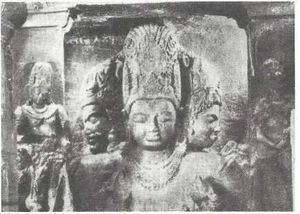Elephanta
By Swami Harshananda
Elephanta is an island situated about 11 kilometers (7 miles) to the north east from the Bombay (now Mumbai) harbor. Its
circumference is about 7 kilometers (4 miles).
Its original name was Śripuri or Ghārāpuri. It was attached to the Konkan region of Maharashtra. It was under the political control of several dynasties of kings like Western Cālukyas, Cālukyas under Pulakeśin II (CE 600), the Yādavas of Devagiri and so on, before coming under British rule in CE 1774.
Archeological Significance[edit]
The island got its name due to the idols of elephants which are now missing on the steps of one of the temples there. It is famous for its archaeological monuments especially the six cave temples belonging to the Śaiva sects assigned to the 8th century CE. Some of the characteristics of the biggest caves is:
- The largest of these caves in solid rock faces north. It is 39 meters (130 ft.) long and the width is also approximately the same.
- There are mukhamaṇṭapas, subsidiary halls, measuring 16 meters (54 ft.) by 5 meters (16 | ft.) in the west, the north and the east.
- The average height is 5 meters (16 to 17 ft.).
- There is a small sanctum with a liṅga, towards the west.
- It also has two figures of the dvārapālakas.[1]
- The Elephanta caves contain a number of huge idols(of the relief type) of the Śaiva cult. Idols are 3.6 to 5.4 meters (12 to 18 ft.) in height.
- The most important of these idols is that of Maheśvara Śiva. It is also called ‘Trimurti-Śiva’.
- The main face represents the Tatpuruṣa or Mahādeva aspect of Śiva. This face is serene and beautiful. It has a jaṭāmukuṭa.[2]
- The other two faces are those of Aghora or Bhairava and Vāmadeva or Umā.
- The depiction of several often contradictory moods in the same image shows the excellence of workmanship.
- The whole idol is sculptured from the chest upwards.
- The idol is inside a depression in the back wall, 3 meters (10 ft.) in depth and 6 meters (21 ft.) in width.
- There are eight more idols of Śiva in his various aspects. Some of them are:
- Naṭarāja, Śiva in meditation
- Rāvaṇa shaking the Kailāsa mountain
- Śiva killing Andhakāsura and Ardhanārīśvara
References[edit]
- ↑ Dvārapālakas means the gate-keepers.
- ↑ Jaṭāmukuṭa is the hair dressed up as a crown.
- The Concise Encyclopedia of Hinduism, Swami Harshananda, Ram Krishna Math, Bangalore

